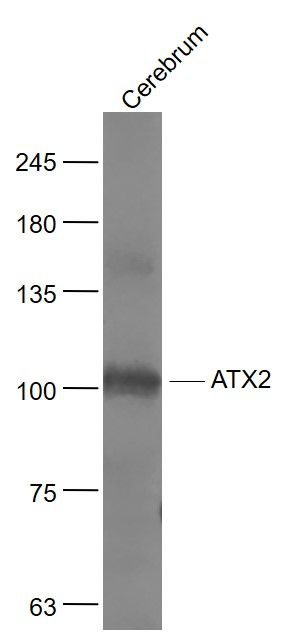产品货号 : mlR7974
英文名称 : ATX2
中文名称 : 脊髓小脑共济失调2型蛋白抗体
别 名 : Ataxin 2; ATXN2; Olivopontocerebellar ataxia 2, autosomal dominant; SCA2; Spinocerebellar ataxia type 2 protein; TNRC13; Trinucleotide repeat containing gene 13 protein; SRRT_HUMAN.
研究领域 : 细胞生物 免疫学 神经生物学 表观遗传学
抗体来源 : Rabbit
克隆类型 : Polyclonal
交叉反应 : Human, Mouse, Rat, Chicken, Dog, Pig, Cow, Horse,
产品应用 : WB=1:500-2000 ELISA=1:500-1000 IHC-P=1:400-800 IHC-F=1:400-800 IF=1:100-500 (石蜡切片需做抗原修复)
not yet tested in other applications.
optimal dilutions/concentrations should be determined by the end user.
分 子 量 : v101kDa
细胞定位 : 细胞浆
性 状 : Lyophilized or Liquid
浓 度 : 1mg/ml
免 疫 原 : KLH conjugated synthetic peptide derived from human ATX2:775-856/1313
亚 型 : IgG
纯化方法 : affinity purified by Protein A
储 存 液 : 0.01M TBS(pH7.4) with 1% BSA, 0.03% Proclin300 and 50% Glycerol.
保存条件 : Store at -20 °C for one year. Avoid repeated freeze/thaw cycles. The lyophilized antibody is stable at room temperature for at least one month and for greater than a year when kept at -20°C. When reconstituted in sterile pH 7.4 0.01M PBS or diluent of antibody the antibody is stable for at least two weeks at 2-4 °C.
PubMed : PubMed
产品介绍 : The autosomal dominant cerebellar ataxias (ADCA) are a heterogeneous group of neurodegenerative disorders characterized by progressive degeneration of the cerebellum, brain stem and spinal cord. Clinically, ADCA has been divided into three groups: ADCA types I-III. ATX2 belongs to the autosomal dominant cerebellar ataxias type I (ADCA I) which are characterized by cerebellar ataxia in combination with additional clinical features like optic atrophy, ophthalmoplegia, bulbar and extrapyramidal signs, peripheral neuropathy and dementia. ATX2 is caused by expansion of a CAG repeat in the coding region of ATX2. Longer expansions result in earlier onset of the disease. There are four named isoforms.
Subunit:
Monomer. Can also form homodimers.
Subcellular Location:
Cytoplasm.
Tissue Specificity:
Expressed in the brain, heart, liver, skeletal muscle, pancreas and placenta. Isoform 1 is predominant in the brain and spinal cord. Isoform 4 is more abundant in the cerebellum. In the brain, broadly expressed in the amygdala, caudate nucleus, corpus callosum, hippocampus, hypothalamus, substantia nigra, subthalamic nucleus and thalamus.
Similarity:
Belongs to the ataxin-2 family.
SWISS:
Q99700
Gene ID:
6311
Important Note:
This product as supplied is intended for research use only, not for use in human, therapeutic or diagnostic applications.
产品图片












